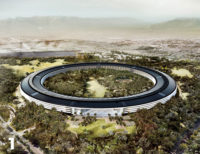
Kresge Auditorium
Photo courtesy MIT/Donna Coveney

Carpenter Center for the Visual Arts
Photo courtesy Harvard University

Christian Science Center
Photo courtesy Christian Science Center

John Hancock Tower
Photo courtesy Greater Boston CVB/ FayFoto

Institute of Contemporary Art
Photo © Peter Vanderwarker
6 – Kresge Auditorium
As MIT grew during the 1950s, it hired an all-star line up of architects including Eero Saarinen, who designed the campus’s Kresge Auditorium. The building’s striking dome-shaped roof is actually a segment of a sphere laid on its side so that it touches the ground at three points. Rising to a height of 50 feet, with its side elevations clad in glass, the sphere segment encloses a column-free concert auditorium.
7 – Carpenter Center for the Visual Arts
Le Corbusier’s only building in North America, the Carpenter Center for the Visual Arts at Harvard University, was designed and built at the very end of his life and is a pastiche of the distinct shapes and ideas that made the Swiss-French architect famous. The building’s blocky concrete forms are offset by a long curving entry ramp, while the facades are marked by Le Corbusier’s signature thin columns and sun shades. It’s humorously said to resemble two pianos mating. Completed in 1963, the building houses the Harvard Film Archive, Sert Gallery, as well as classrooms.
8 – Christian Science Center
An ingenious bit of urban planning, the Christian Science Center succeeded where similar projects of the era—such as Boston’s City Hall and its surrounding plaza—failed to engage the community. The Church of Christ, Scientist commissioned I.M. & Partners—later Pei Cobb Freed & Partners—to design a master site plan for its world headquarters at the site of its Mother Church. Completed in 1974, Pei’s plan included a long reflecting pool, a 28-story office tower, an auditorium building, and a colonnaded school building, whose concrete and limestone surfaces play off the existing church. Its pool, capped by a fountain at one end, is especially popular with children during summer months. The Mother Church, built in the 1930s and wonderfully expanded and restored in 2002 by local architect Ann Beha, contains several intriguing spaces including the Mapparium: a globe, 30 feet in diameter, made of brilliantly glowing stained glass. Visitors can step inside the globe’s center and walk from one side to the other. The Mapparium’s representation of the world has not been updated since it was built in 1935: back when the Soviet Union was still going strong, before Israel or Pakistan existed, and when the United States included only the Lower 48.
9 – John Hancock Tower
Boston’s first all-glass skyscraper, the 60-story John Hancock Tower had a rough birth but matured into something wonderful. Critics initially feared the skyscraper would overwhelm H.H. Richardson’s 19th century masterpiece Trinity Church, located immediately next to it in Copley Plaza. Then, during construction, more than a third of the tower’s 10,000 glass windows fell out and were replaced with plywood, earning the building the sobriquets “plywood palace” and “the tallest wooden building in the world.” But since the Hancock building’s completion in 1976, most observers have come to appreciate how its shiny glass windows—now tightly secured—actually help to showcase Trinity Church. When the trapezoidal-shaped tower is viewed from certain angles, its mass literally dissolves into the sky.
10 – Institute of Contemporary Art
The Institute of Contemporary Art, opened in December 2006, has been described as Boston’s own version of the Guggenheim Bilbao: a museum building whose design is so bold and cutting edge that it raises the profile of an entire city. Located harbor-side on Fan Pier, the ICA is an all-glazed study of cantilevered forms and staircases designed by Diller Scofidio + Renfro: the firm’s first free-standing building in the United States and the first all-new art museum building in Boston in more than 100 years.

